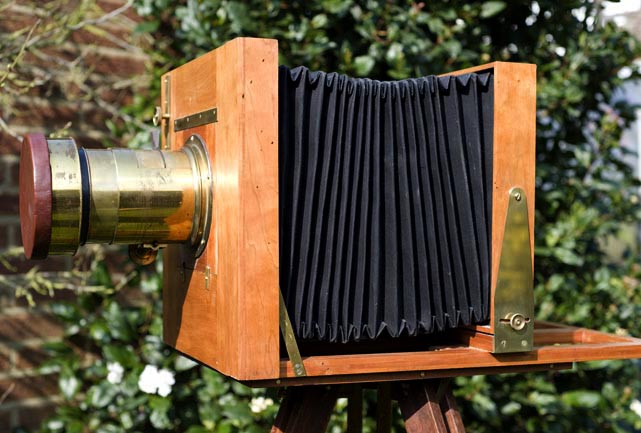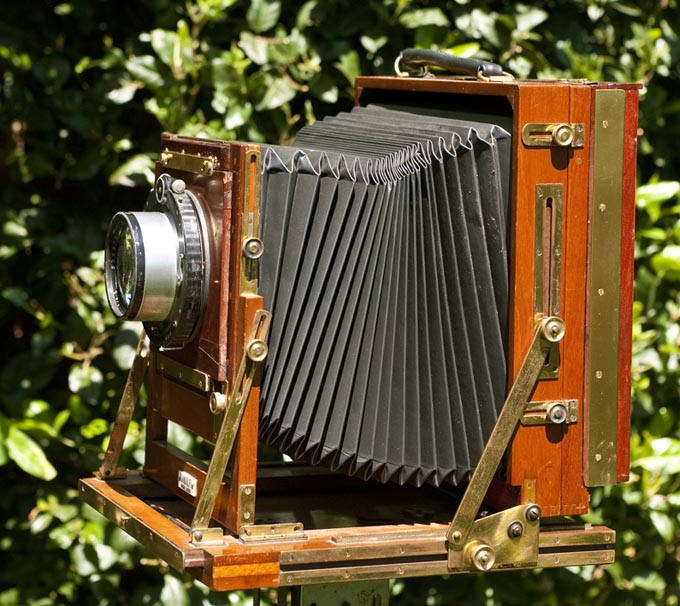.
.
Mahogany half plate Sliding Box Camera
The rise and fall lens panel is mounted with a Dallmeyer 2B f.3 ordinary Petzval portrait lens made in 1862.
Although it is fairly easy to find original lenses designed for the wet collodion process, the situation with cameras is very different. Original cameras dating from the 1850s or 1860s are rare and very expensive, and far too important to be used in the field some 150 years after they were made.
So, the wet collodion photographer anxious, when demonstrating the process, to use equipment that faithfully represents that used in the 1860s has few options to follow. Either make the cameras and associated equipment himself or purchase it from an experienced maker of wet collodion equipment*.
George Eastman House Photographic Museum web site has an excellent online display of early cameras and it is not difficult to find suitable models to copy.
The example above is known as a sliding box camera because the camera body is made up of two boxes, one sliding within the other. This type of camera is typical of the kind that travelling photographers of the period would have used. They were relatively inexpensive and robust. Coarse focus was achieved by adjusting the sliding box, fine focus was achieved by using the rack and pinion control on the lens.
This sliding box takes half plate (U.S.half plate, 51/2" x 41/4") and smaller size plates, such as quarter, sixth and ninth plate.
My next camera is a stereo camera, based on the style of those sold by Dallmeyers in the 1860s. It has a rising front and endless screw focusing .On it are mounted a pair of Burr Stereo lenses, these date from the 1860s and were made in London.
.
Mahogany Stereo Camera with Burr stereo lenses
The two lenses on the panel in front of the camera are a pair of Dallmeyer Quick Acting "Landscape" lenses.
.
The last camera is a 10"x8" made from cherry wood, and is based on a camera manufactured by E.& H.T.Anthony in the 1870s. With a rise and fall front panel and a tilting back, it is useful for both portraiture and landscape work and can take lenses from the half plate Dallmeyer 2B upwards to the 4D

Cherry wood 10"x8" Anthony style camera with a Dallmeyer 3A Patent portrait lens.
.
My latest acquisition, a Gandolfi 10x8.
I found this on ebay last year, it was very shabby but with some TLC and new bellows it's now fine. It bears my latest Dallmeyer, a 12", f4.5 Serrac made in 1960. This is mounted in a working large compound shutter so with an air release I can even try self portraits.
.
At one time I had some twenty two Dallmeyer lenses, mostly portrait and rapid rectilinear types.
Most of these I have sold and I now confine myself to 2B, 3B, 3A and 4D Patent portrait lenses along with whole plate, 10"x8" and 12"x10" Rapid Rectilinears.
.
To see some of the ambrotypes and ferrotypes I have produced, please go to my results page, my Folk Park page, or my other results pageAnti Spam
Since this web site was first constructed I have given up photographing at historical reenactments, so any one interested in my current activities should look at my Present Work page.
To see some details of my developing box and my camp set up, please go to my equipment page
Please view my Frederick Scott Archer page.
Return to my home page
.
On occasion I am asked if I will make cameras for other photographers.
I do not do so but I am happy to strongly recommend the equipment made by
